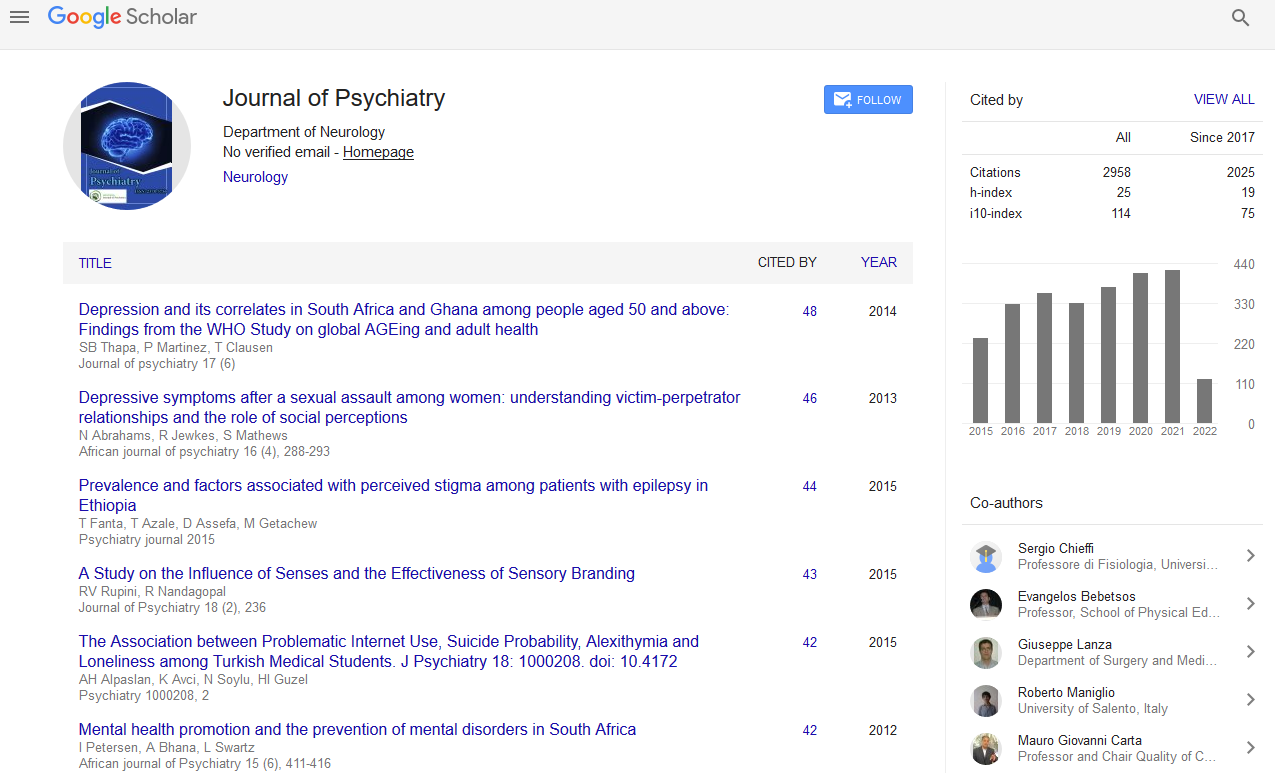PMC/PubMed Indexed Articles
Indexed In
- RefSeek
- Hamdard University
- EBSCO A-Z
- OCLC- WorldCat
- SWB online catalog
- Publons
- International committee of medical journals editors (ICMJE)
- Geneva Foundation for Medical Education and Research
Useful Links
Share This Page
Open Access Journals
- Agri and Aquaculture
- Biochemistry
- Bioinformatics & Systems Biology
- Business & Management
- Chemistry
- Clinical Sciences
- Engineering
- Food & Nutrition
- General Science
- Genetics & Molecular Biology
- Immunology & Microbiology
- Medical Sciences
- Neuroscience & Psychology
- Nursing & Health Care
- Pharmaceutical Sciences
Structural brain correlates of adolescent risk-taking and peer influence susceptibility
Joint Event on World Congress on Psychiatry & Psychological Syndromes & 29th International Conference on Adolescent Medicine and Child Psychology
December 06-07, 2018 | Rome, Italy
Gregory J Knowles and Renate L E P Reniers
University of Birmingham, UK
Posters & Accepted Abstracts: J Psychiatry
Abstract:
Statement of the Problem: Adolescence is characterised by an increased propensity to engage in risky behaviour, in part the result of a heightened susceptibility to peer influence. We aimed to investigate whether adolescent risk-taking and peer influence susceptibility (PIS) had any relation to brain structure. Methodology: A sample of 27 healthy adolescents (15 males, 12 females; age 17-23 years) participated in this study. We adapted the Balloon Analogue Risk Task so that participants completed it twice alone and twice after exposure to peer encouragement. The alone condition objectively measured baseline risk-propensity. Taking the percentage difference between conditions formed an empirical index of PIS. Using voxel-based morphometry, we compared baseline risk-propensity and PIS scores to grey and white matter volumes in whole-brain multiple regression analyses. Findings: We identified a statistically significant positive correlation between baseline risk-propensity and white matter volume of the right posterior cerebellar lobule VII (p<0.01, FWE-corrected). Secondly, PIS scores were associated with volumetric variations in the right precuneus, right ventrolateral prefrontal cortex (VLPFC) and left dorsolateral prefrontal cortex (DLPFC) (p<0.001, uncorrected). Conclusion: Across late adolescence, cerebellar volumes decline through mechanisms like synaptic pruning. Considering this, our research suggests a link between reduced lobule VII structural maturity and increased risk-propensity. We remain in the early stages of learning about the cognitive cerebellum. However, functional topographical studies demonstrate the recruitment of lobule VII specifically during cognitively-demanding, rather than movement-orientated, tasks. Perhaps lobule VII immaturity hinders the engagement of cognitive resources in decision-making, causing less risk-averse behaviour. With regards to PIS analyses, our study is the first to empirically investigate its structural correlates. Existent fMRI research implicates the DLPFC, VLPFC and precuneus in social cognition. While we provide preliminary evidence for a specific association between these regions and PIS, larger studies are needed to elucidate their exact contribution to task performance. Recent Publications: 1. Steinberg L (2008) A social neuroscience perspective on adolescent risk-taking. Developmental Review 28(1):78-106. 2. Kwon M S, Vorobyev V, Moe D, Parkkola R and H�m�l�inen H (2014) Brain structural correlates of risk-taking behavior and effects of peer influence in adolescents. PLOS ONE 9(11):e112780. 3. Romer D, Reyna V F and Satterthwaite T D (2017) Beyond stereotypes of adolescent risk taking: Placing the adolescent brain in developmental context. Developmental Cognitive Neuroscience 27:19-34. 4. Tiemeier H, Lenroot R K, Greenstein D K, Tran L, Pierson R and Giedd J N (2010) Cerebellum development during childhood and adolescence: a longitudinal morphometric MRI study. Neuroimage 49(1):63???70. 5. Stoodley C J, Valera E M and Schmahmann J D (2012) Functional topography of the cerebellum for motor and cognitive tasks: an fMRI study. Neuroimage 59(2):1560-70.
Biography :
Gregory J Knowles is a 4th year medical student studying at the University of Birmingham, UK. Considering a career in psychiatry, he has completed an intercalated BMedSci in Psychological Medicine. Inspired by the work of renowned developmental neuroscientists (Casey et al., 2008; Steinberg, 2008), he orientated his year towards the analysis of research into adolescent social neuroscience. He aimed to investigate the neural components underlying well-recognised risky tendencies during this period. Previous study in this area focused predominantly on the utilisation of functional magnetic resonance imaging. Employing a different approach, he applied voxel-based morphometric analysis to evaluate the association between risk-propensity and grey and white matter volumes (and hence, maturity). Furthermore, since most risks are taken in the presence of peers, he also investigated the association between peer influence susceptibility and brain structure. His research provides some preliminary findings to build upon in the future.
E-mail: GJK448@student.bham.ac.uk


